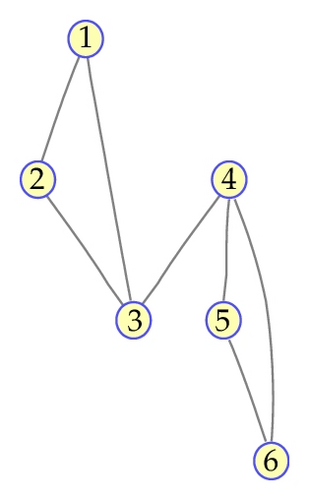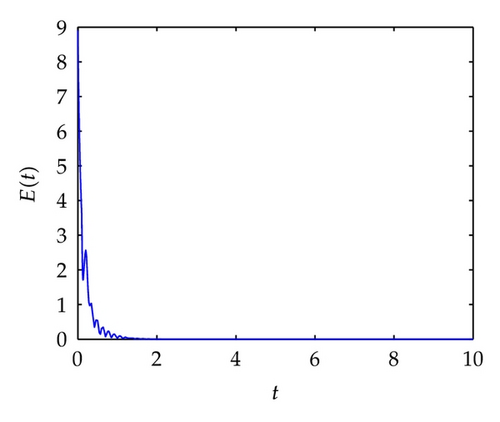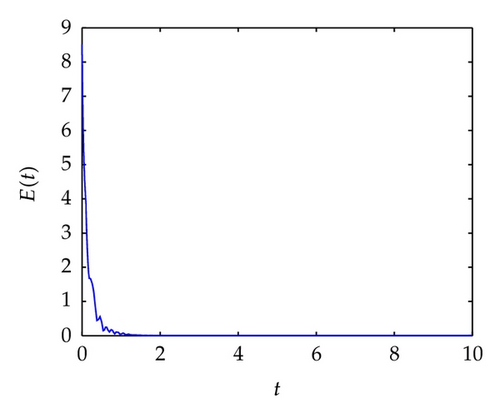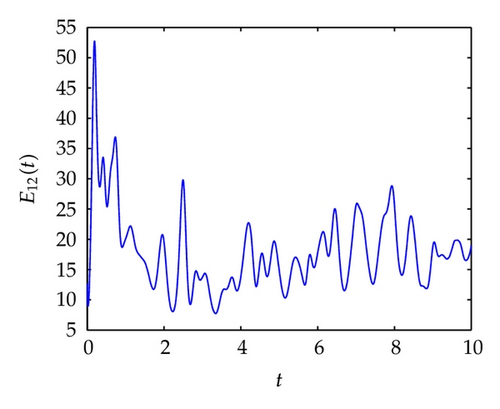Adaptive Cluster Synchronization for Nondelayed and Delayed Coupling Complex Networks with Nonidentical Nodes
Abstract
We focus on the cluster synchronization problem for a kind of general networks with nondelayed and delayed coupling. Based on the pinning control scheme, a small fraction of the nodes in each cluster are pinned for successful control, and the states of the whole dynamical networks can be globally forced to the objective cluster states. Sufficient conditions are derived to guarantee the realization of the cluster synchronization pattern for all initial values by means of the Lyapunov stability theorem and linear matrix inequalities (LMIs). By using the adaptive update law, relative smaller control gains are obtained, and hence the control cost can be substantially lower. Numerical simulations are also exploited to demonstrate the effectiveness and validity of the main result.
1. Introduction
In the past few decades, synchronization and control problems are being widely studied [1–9]. Synchronization can be understood as the adjustment of rhythms or coherence of states by interaction [8] and realized via a sufficient information exchange among the nodes’ interconnection in dynamical networks. The meaning of synchronization can interpret the essence of the collective behavior in nature and it has many potential applications in such areas as biological systems [1], secure communications [3], information processing, mechanical engineering, identification and pattern recognition [4], neuronal networks [2, 6, 7, 9], and so forth. In literature, there are many widely studied synchronization patterns, which define the correlated in-time behaviors among the nodes in a dynamical network, such as phase synchronization [3], impulsive synchronization [4], and complete synchronization [5].
Cluster synchronization has been well studied in recent works [10–14]. It requires that the coupled oscillators split into subgroups called clusters, such that the oscillators synchronized with one another in the same cluster, but there is no synchronization among different clusters. In [11], Wu et al. acquired a general network to a selected cluster synchronization pattern by means of a pinning control strategy. Wang et al. in [12] considered the dynamical networks with community structure and nonidentical nodes and with identical local dynamics for all individual nodes in each community, a way to design the controllers is very far-reaching, which motivates the present study. In [13], the cluster synchronization in an array of hybrid coupled neural networks with delay was investigated by Cao and Li. A method to realize cluster synchronization by constructing a special coupling matrix was proposed and several sufficient conditions for cluster synchronization based on the Lyapunov stability theory and the linear matrix inequality (LMI) technique were derived.
Some networks could achieve synchronization by utilizing information exchanges among local connections, while most networks in reality are generated randomly, which means they could not fulfill synchronization only depending on the coupling without using external forces. Hence, in many cases, negative state feedback control schemes are necessary to be designed to force the final synchronous state into a certain required objective trajectory. In the previous work [11], Wu et al. have proved that one can always pin a coupled complex network by adding some negative feedback controllers if the control strength is large enough. However, in practice, it is not allowed that the control gains are arbitrarily large. For synchronization, it was pointed out that theoretical values of the control gains are much larger than needed in practice. Therefore, one may ask: Can we find the sharp bound of the control gains? Similarly, in a pinning process, it is also important to make the control strength as small as possible. Some results about the adaptive adjustment control were presented in [15–19]. In [15], Lu and Cao proposed a simple scheme for the synchronization of an uncertain complex dynamical network with delayed coupling. The adaptive controllers to ensure the states of uncertain dynamical network with coupling delays to globally asymptotically synchronize were designed. A class of chaotic neural networks with known or unknown parameters by using the adaptive control and linear feedback with update law was investigated by He and Cao in [16]. They derived an adaptive feedback scheme to achieve synchronization of two coupled neural networks with a time-varying delay.
It is worth noticing that most of the studies on cluster synchronization for complex dynamical networks have been performed under some implicit assumptions that there exists the information communication of nodes via the edges only at time t or at time t − τ. However, in many circumstances, this simplification does not match satisfactorily the peculiarities of real networks: there exists the information communication of nodes not only at time t or t − τ but also at time t, t − τ. This general complex dynamical network model with time nondelayed and delayed coupling was investigated in [14, 20–23] and so forth. In [21], Xu and Su studied the general complex dynamical networks for synchronization and pinning control, they obtained less conservative criteria for both continuous-time and discrete-time complex dynamical networks with time delayed and nondelayed coupling by linearizing the system, and hence their results were established locally. Lou et al. discussed the adaptive synchronization of two complex networks with nondelayed and delayed couplings in [22]. They found that the coupling configuration matrices were not necessarily symmetric or irreducible and presented several criteria for synchronization of the two complex networks based on the Lyapunov stability theory. The exponential cluster synchronization of coupled impulsive genetic oscillators with external disturbances and communication delay was investigated by Zhang et al. in [14]. Some cluster synchronization criteria for the delayed and nondelayed coupling impulsive genetic oscillators were presented and the maximal allowable bound of time delay was obtained as well. However, the cluster synchronization problems for the nondelayed and delayed coupling networks in [14] were established based on the strong assumption that all of the nodes have the same dynamical behaviors.
In this paper, we study the cluster synchronization problem for a kind of general complex dynamical networks with time nondelayed and delayed coupling. We emphasize that the dynamical behaviors of the nodes in different clusters are distinct too. Some global synchronization criteria are derived by means of the pinning control method. The adaptive adjustment controllers are designed skillfully as they have the potential ability to obtain more suitable control gains, which are more important in reality. Moreover, we apply the Lyapunov stability theorem to ensure the realization of cluster synchronization. The required global synchronization criteria then follows immediately from the LMIs.
The rest of the paper is organized as follows. In Section 2, we present some preparations and the general complex dynamical network model. In Section 3, we analyze the cluster synchronization of the network with time nondelayed and delayed coupling under the adaptive control. Numerical simulations are given to verify our theoretical results in Section 4. Concluding remarks are drawn in Section 5.
Notations. The mark AT denotes the transport of the matrix A. Rn denotes the n-dimensional Euclidean space. Rn×n are n × n real matrices. diag {⋯} stands for a diagonal matrix. The sign ∥·∥ stands for the Euclid norm of the matrix or the vector. A symmetric real matrix A is positive definite (semidefinite) if xTAx > 0 (≥0) for all nonzero x we denote this as A > 0 (A ≥ 0). I stands for the identity matrix with proper dimension. The dimension of these vectors and matrices will be cleared in the context.
2. Preliminaries and Model Description
We first make some assumptions for a network with cluster structure as follows. Suppose that these networks have N nodes and m clusters with N > m ≥ 2. Let μi = j if node i belongs to the jth cluster. Denote Uj as the set of all nodes in the jth cluster and as the set consisting of all nodes in the jth cluster which have direct connections to the nodes in other clusters. Thus we have (1) Ui ⋂ Uj = ϕ, for i ≠ j and i, j = 1,2, …, m; .
Some preliminaries such as definitions and lemmas will be given in the following, which are necessary throughout the paper.
Definition 1 (see [24].)Synchronization manifold
Definition 2 (see [12].)A network with N oscillators is said to achieve cluster synchronization if it satisfies
Definition 3 (see [11].)Function class QUAD(Δ, P, η): let Δ = diag {δ1, …, δn} be a diagonal matrix and P = diag {p1, …, pn} a positive-definite diagonal matrix. QUAD(Δ, P, η) denotes a class of continuous functions f(x, t) : Rn × [0, +∞) → Rn satisfying
Lemma 4 (Schur complement [25]). The following linear matrix inequality (LMI)
- (1)
Q(x) > 0, R(x) − S(x) TQ(x) −1S(x) > 0;
- (2)
R(x) > 0, Q(x) − S(x)R(x) −1S(x) T > 0,
3. The Stability Analysis for Cluster Synchronization under Pinning Adaptive Control
In this section, the cluster synchronization problem amounts to proving the stability of the error system. By using a suitably chosen control scheme, that is, pinning adaptive controllers that control only a fraction of the nodes in every cluster which have direct connections with the nodes in other clusters will be designed to globally stabilize the dynamical network with nondelayed and delayed coupling. We present the main result of this paper in the form of Theorem 6, then give the detailed proof process.
Remark 5. Through the above controllers, the first term in (10) is used to synchronize all nodes in the same cluster, while the remainder term in the controller is to weaken the mutual influences among clusters at the intersection nodes. By the way, we design the adaptive gains as (11) (adaptive update law) in order to make the control strength as small as possible, and hence the control cost can be substantially lower and our strategy can be easier to implement.
In the following, the main result of cluster synchronization criteria for nondelayed and delayed coupling under the pinning adaptive control scheme (10) and the adaptive update law (11) will be given.
Theorem 6. Suppose , i = 1, …, N, such that
Proof. For notational convenience, we denote
Remark 7. The main theory explicitly showed a kind of effective and relatively cheap control strategy control scheme designed in this paper for the cluster synchronization of complex dynamical networks. That is, throughout the above proof, we can get some relative proper and practical control gains by using the pinning control scheme (10) as well as the adaptive control gains update law (11). Therefore, we can save much resources and costs for the smaller control gains than the previous works got in [11, 12]. Although one can pin a coupled complex network by adding some negative feedback controllers if the control strength is large enough, it is not practical that the control gains are arbitrarily large.
In the following, we give two corollaries, which are the investigation of simplified complex networks (6). Those results could come to the conclusion that our main result in this paper is more comprehensive and meaningful than the previous ones.
Corollary 8. Suppose , i = 1, …, N, such that
Remark 9. The similar proof process of Corollary 8 could be thought of as the simplified process of Theorem 6. Similar conclusion also can be found in [12]. In this special case, we investigate the complex network without time delay.
Corollary 10. Suppose , i = 1, …, N, such that
Remark 11. The proof of Corollary 10 could be thought of as another simplification of the proof of Theorem 6; this corollary, of course, is another special situation of the main result, that is, the network with time delayed coupling. This corollary can tells the result in this paper including the previous works, so we did a more comprehensive work.
4. Numerical Simulation
The above criteria can be applied to networks with different topologies and sizes. In this section, we put an effective example to illustrate the validity of the theory given in previous sections.
Example 12. We use a chaotic Lorenz oscillator and a chaotic Chua’s oscillator with different parameters, respectively, as the example to illustrate the main results (Theorem 6) of our paper. The chaotic Lorenz oscillator model could be described as follows:




According to the conditions in Theorem 6, we know that the cluster synchronization manifold M is globally stable for any positive time delay τ. We plot the curves of the cluster synchronization errors of each cluster in Figure 1 (Figures 1(b) and 1(c) stand for cluster synchronization errors in cluster 1 and 2, resp., and Figure 1(d) represents for the error between two communities). It is clear that the cluster synchronization is achieved if E(t) converges to zero and E12(t) do not as t → +∞. The pinning adaptive controllers give a successful realization of cluster synchronization with the varying control gain d(t); in this situation, we derive the control gain matrix D = 24I. It is more practical in real applications than we got in the view of theories.
5. Conclusion
This paper considered a class of complex dynamical networks with time nondelayed and delayed coupling. Instead of controlling all nodes, pinning adaptive control was used to pin a small fraction of the nodes in each cluster for successfully control, and the states of the whole dynamical networks can be globally exponentially forced to the objective cluster states. We have derived sufficient criteria for cluster synchronization under pinning control as the situation of dynamics are different in every cluster, which is more practical and meaningful in realistic. The adaptive method to adjust the control gains suitably rather than as large as possible was introduced and global synchronization of the general complex networks were achieved by using the Lyapunov stability theorem and linear matrix inequality. The numerical simulation was exploited to demonstrate the effectiveness of the pinning adaptive strategy proposed in this paper.
Acknowledgments
The authors thank the referees and the editors for their valuable comments on this paper. The work is supported by the Natural Science Foundation of China (Grant no. 61273220), Guangdong Education University Industry Cooperation Projects (Grant no. 2009B090300355), and the Shenzhen Basic Research Project (JC201006010743A, JCYJ20120613105730482).




